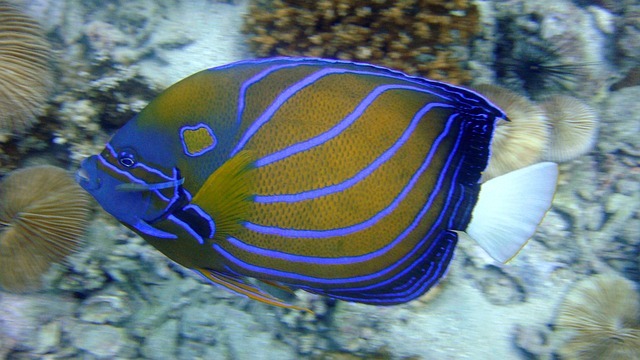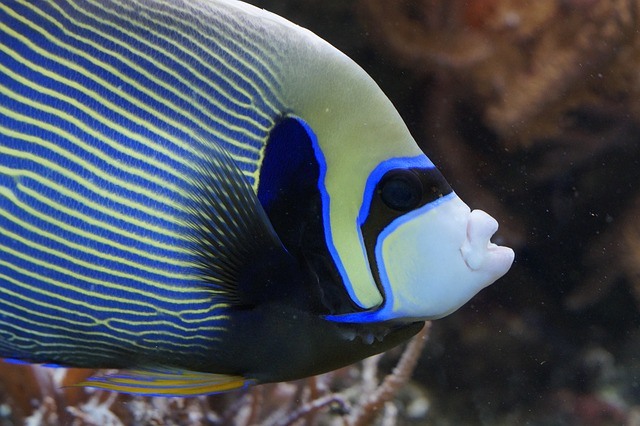Angelfish are a great starter fish for your aquarium. Available in a variety of colors and with their long, flowing fins, it’s easy to see why they are so popular.
Luckily, they are also relatively easy to care for! They come in a large variety of sizes, and because they are easy to breed in captivity, it’s easy to get healthy fish that are not taken from their natural environment, so you can feel good about your purchase.
They are generally pretty inexpensive as well, though it depends on the color and subspecies.
Flashy and territorial, are these striking angels right for your tank?
Let’s take a look!
Contents
Angelfish Appearance and Personality
Behavior and Origin
Angelfish originated in the Amazon River basin and other rivers in South America. They are of the genus pterophyllum, and part of the Cichildae family.
In the wild, they hide in long grasses and floating wood, and ambush small fish or invertebrates. They mate in monogamous pairs, and aggressively protect their eggs until they hatch.
Most angelfish species available in pet stores are captive bred, so you don’t have to worry about taking these beautiful fish away from their home.
Appearance and Gender
They can live 10-12 years if cared for properly. They can get up to 6 inches long, and 12 inches high, so be sure you have enough vertical space for these elegant fish.
They are typically active during the day, so they are sure to make a beautiful addition while you are up and about.
Angels can be challenging to determine the sex of, and you may not find out if you have a male and female in your tank until the eggs or fry appear.
If you have a group of angelfish, males and females will naturally pair off. Some older males may have an obvious bump on their forehead, but otherwise, there is very little sexual dimorphism.
Health Concerns
Disease can be introduced to the tank when you add anything that has not been properly cleaned or quarantined, including live rock, corals, and fish.
The best prevention is proper care and the cleaning of anything new going into the tank, as well as making sure that you provide quality food, good water, and proper tank mates.
Specific to angelfish is something called the angelfish virus, which can be identified by excessive slime and clamped fins. They can also have white chalky feces, a lack of appetite, and weight loss.
Unfortunately, there is no cure, so the fish should be removed from the tank to prevent infecting tank mates. Angelfish with a strong immune system will recover from the disease on their own, but it is oftentimes fatal.
Angelfish can also contract ich, which is a parasite that causes white spotting. Treat the water with ich medication, and your fish should recover without problem.
Angelfish Care
Tank Requirements
Because angelfish can grow so tall, it is important to give them a tank big enough to accommodate their growth. The tank should be at least 30 gallons, but a larger tank will allow more fish.
You can start your fish in a smaller tank, as long as you are prepared to move them as they grow.
As a general rule, your angelfish will be healthier when placed in a tank above the basic requirements. They need plenty of space to move, both vertically and to make the wide turns required with their long fins.
Angelfish are not strong swimmers, so be sure your filter does not create a current that is too turbulent. Angels also prefer a quiet tank, without a lot of activity or splash from the filters, so it may be better to have an undergravel filter.
A hood is recommended for the tank too; although angelfish typically are not jumpers, it helps prevent debris from falling in.
When selecting décor, it’s important to remember that angelfish have relatively fragile fins. It’s best to go with live plants, or silk plants, as hard plastic ones may damage your fish.
They may eat real plants, but this is natural and healthy for them; simply replace whatever they nibble on.
They like a lot of plants to hide in, as it would most closely mimic their natural environment in the Amazon basin. Without this protection, they may become stressed, and then sick.
Any decorations should not have holes and crevices that may snag your angel’s fins. They are not particular about the type of substrate, as they don’t normally hang near the bottom of the tank.
Water Requirements
As with all fish tanks, the water, substrate, and decorations should be cycled in the tank before fish are introduced.
The pH level should be between 6 and 7.5 and pH can be tested with any home test kit.
Angelfish also prefer a tank with a lot of substrate and vegetation, and plenty of places to hide.
The water in the tank should be between 75 and 84 degrees Fahrenheit to keep your fish healthy. You may need to invest in a tank heater to keep this range.
Angelfish prefer the warmer end, and if they find the water is too cold, they may crowd around the heater. If you see this, it may be a good idea to turn up the temperature a few degrees.
They may also need a light during the day if the tank does not get natural sunlight. This will not only reduce stress on the fish, but help give them a consistent schedule.
Introducing Them to the Tank
If you already have fish in your tank and want to add an angelfish, the best way to do so is in a quarantine tank first. This not only keeps a potentially sick fish away from the others, but it allows the new fish to get used to the water and food you are providing, reducing stress.
Before you remove your angelfish from quarantine, make sure that the tank has plenty of places for the angelfish to hide. Rearrange the current layout of your tank to distract the existing fish and remove any established territories.
Feed your current fish right before introducing the new one, which will make them less aggressive. It is also better to introduce more than one new fish at once, as it reduces the chances of the new guy being singled out and aggravated.
And, as always, make sure you water is clean and appropriately balanced to reduce stress in all of the fish.
If you get an Altum angelfish, or a Leopold’s angelfish, it is especially important to quarantine them first, as these species are often wild-caught and are more likely to introduce parasites or diseases to your tank.
These species are not recommended to purchase, as they can be more challenging to keep healthy; they have very specific water requirements, and are known to stop eating when stressed.
They also tend to be more expensive than captive-bred angelfish, and aren’t necessarily more desirable in color or appearance.
Tank Maintenance
Once a tank is set up and the fish are happy, water changes are the best way to maintain a healthy tank.
Smaller tanks require more frequent water changes because toxins such as ammonia and nitrates build up more quickly compared to larger tanks. Regular water changes and good filters are more important the smaller the tank.
Once a week, take out the filter and clean it, and change the tank water at least once a month.
Replace 10-25% of the tank’s water each month, and make sure you check the temperature and pH afterwards to maintain your healthy tank environment.
Here’s a video showing an angelfish tank set-up.
Angelfish Food
Angelfish are opportunistic eaters, but are primarily carnivores and should have a diet reflecting this.
Cichlid pellets and flakes are good, but angelfish enjoy being supplemented with live food such as brine shrimp, bloodworms, meal worms, and small insects and crustaceans.
Young angelfish need live food more often than older fish. They can also eat slices of veggies such as peas or zucchini, and may snack on live plants.
They should be fed two to three times a day, but watch how much you feed them, as angelfish will overeat readily.
An overfed angel is actually going to be less healthy than an underfed angel, so make sure you keep a close eye on their weight and behavior.
Angelfish Tankmates
Angelfish are fairly aggressive, so tank mates should be chosen with care. As a general rule, stick to other angelfish, or fish about the same size, as they may attack and eat smaller fish.
They do like to be community fish with other angelfish, however, and do best in pairs in smaller tanks, and groups of five or more in larger tanks.
Angelfish do not do well without at least one other of their species; make sure to have at least a pair.
If you are putting them in a tank with other similar-sized fish, avoid ones like Tiger Barbs, which tend to nip at long fins like the angelfish have.
Also make sure to avoid sucker fish, especially the Chinese algae eater, as they may attach to the flat side of the angelfish and injure them.
When properly cared for, angelfish are a friendly and beautiful addition to your tank. A tank full of angels will be peaceful and graceful, perfect to help you create more relaxation in your home.
With a bit of love, they can be a colorful spot for years to come.
Do you own any Angelfish?






